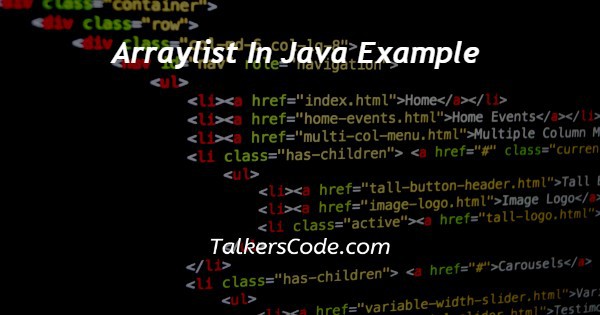In this article we will show you the solution of arraylist in java example, a class called ArrayList is part of the Java collection system and is found in the java.util package.
In Java, it offers us dynamic arrays. In situations where extensive array manipulation is required, it can be useful even if it might be slower than ordinary arrays.
This class can be found in the java.util package.
One of the primary advantages of utilising an array list is that, unlike when defining an arrays, in which the size must be supplied, an array list gives you the option to specify the size.
Now move to the concept of Arraylist in java example.
Step By Step Guide On Arraylist In Java Example :-
A Java ArrayList class is used to create a dynamic array to hold the elements. Array-like, but without any size constraints.
Anytime is a good opportunity to add or remove componentsIt is therefore substantially more flexible than a traditional array.
The ArrayList object in Java supports the adding of duplicate elements.
The List interface is implemented, allowing us to use all of its functions in this context.
The ArrayList records the insertion order on its internal database. The class inherits from AbstractList and implements the List interface.
The ArrayList class in Java allows for duplicate elements. The order of insertion is maintained by the Java ArrayList class. The Java class for array lists is not synchronised.
Because there needs to be far more shifting when an element is deleted from an array list than there is in a Java LinkedList, manipulation of an array list is a tiny bit slower.
Primitive types like int, float, char, and others cannot be included in an array list. Such situations need the usage of the required wrapper class.
import java.util.*;
public class TkArrayList{
public static void main(String args[]){
ArrayList<String> list=new ArrayList<String>();
list.add("Mango");
list.add("Apple");
list.add("Banana");
list.add("Grapes");
Iterator itr=list.iterator();
while(itr.hasNext()){
System.out.println(itr.next());
}
}
}
- The java.util package is first imported into the programme, and then the public class TkArrayListEx is created.
- Once the arraylist has been created, we begin by calling the main function, which uses public static void main string args.
- Afterwards, we add the object, which is an arraylist of fruit names in string form.
- The list is then iterated over. A collection looping object, such as an ArrayList or HashSet, is referred to as an iterator. It is referred to as an iterator since looping is technically known as iterating.
- The hasNext method in Java is then used to determine whether the iterator has the elements.
- When a given list iterator traverses a given list using the forward direction, the hasNext() function of the ListIterator interface will be called to return true if there are more elements than the set limit.
- After printing the element using the next() method and the print command, we go on to the next element.
- The next member in the specified list is returned using the next() function of the ListIterator interface. The list is iterated through using this way.
Conclusion :-
Thus, we were able to understand the idea of an arraylist using a java example.
Also, we discovered that Java ArrayList class is used to create a dynamic array in which to store the elements. Array-like, but without any size constraints.
A suitable time to include or eliminate components is always. It is therefore substantially more flexible than a traditional array.
It is included in the java.util package.
I hope this article on arraylist in java example helps you and the steps and method mentioned above are easy to follow and implement.














